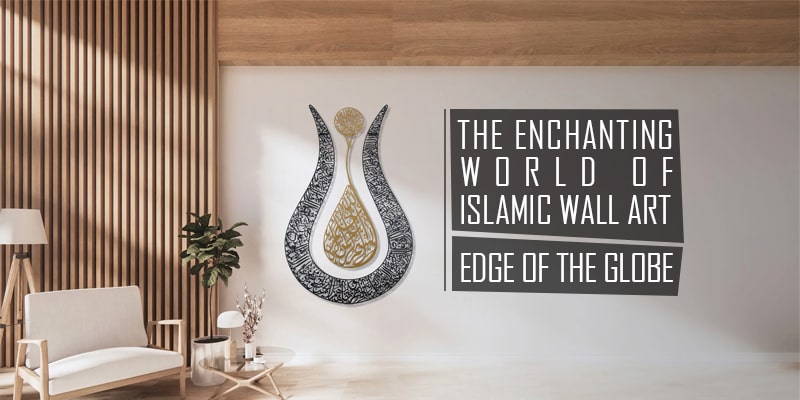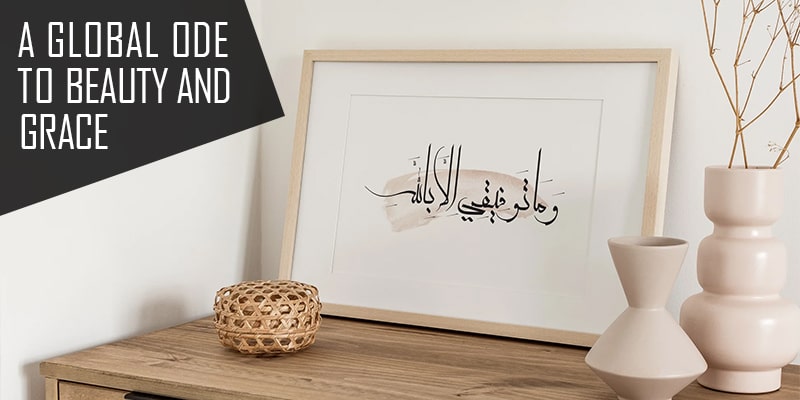Embark on a captivating journey through time, tracing the intricate and vibrant threads of Islamic wall art. We will explore its profound significance, the evolution of its motifs, the techniques employed in its creation, and its contemporary interpretations. Beyond its aesthetic appeal, we will delve into the role of this art form as a vessel of expression and identity, offering insights into the appreciation, collection, preservation, and conservation of these remarkable artistic treasures.

The Enchanting World of Islamic Wall Art
Islamic wall art, a vivid manifestation of the guiding principles and values of the Islamic faith, spans a wide array of art forms. From mesmerizing calligraphy, intricate geometric patterns, and arabesque designs, to delicate floral motifs, these art forms steeped in the richness of Islamic culture have graced the walls of mosques, palaces, homes, and public spaces. Therefore, they stand as a testament to devotion towards Allah and as a medium for creating harmonious and visually captivating environments.
The Integral Role of Islamic Wall Art in Islamic Culture
In the glorious fabric of Islamic culture, Islamic wall art emerges as a remarkable emblem, assuming both an ornamental and sacred function. Owing to the Islamic tradition which often avoids portraying living entities, there has been a surge in the creation of supremely complex geometric patterns and calligraphy as alternative artistic expressions. These artistic forms are not merely visually arresting, but they also symbolize the unity and harmony that permeate the cosmos. Wall art is revered for its capacity to welcome blessings, impart serenity, and provoke thoughtful reflection, thus making it an unerasable element of Islamic architecture and interior design.
Islamic wall art also assumes a vital function in illuminating and reminding adherents of the sacred teachings of Islam. therefore, it frequently intertwines Quranic verses and Hadiths (the treasured utterances of the Prophet Muhammad) within its designs, thus providing a ceaseless reminder of the foundational principles and values of Islam. This harmonious fusion of religious texts and art not only heightens its aesthetic appeal but also amplifies its spiritual resonance.

Embarking on the Historical Journey of Evolution
Unraveling the ancestry of Islamic wall art transports us to the 7th century, to the cradle of Islam in the Arabian Peninsula. The embryonic Islamic art borrowed its allure from a tapestry of influences, tracing its roots to Persian, Byzantine, and Central Asian traditions. With the passage of time, this wall art began to carve its distinguished style, characterized by intricate geometric patterns, captivating calligraphy, and elaborate floral designs.
Under the radiant era of the Umayyad and Abbasid dynasties, the blossoming brilliance of these wall arts was unequivocally evident, particularly in the prevalence of mosaic tilework and stucco reliefs. The rapid proliferation of geometric patterns and calligraphy mirrored a mounting fascination with abstract and non-representational art within Islamic culture. This period also saw the rise of illustrious hubs of Islamic art such as Damascus, Baghdad, and Cordoba, acting as influential catalysts in the evolution and propagation of it.
The Mughal Empire, nestled within the heart of the Indian subcontinent, augmented the splendor of Islamic wall art by fusing Persian, Indian, and Central Asian influences. The Taj Mahal, an emblem of Islamic architecture, splendidly displays the harmonious integration of calligraphy, geometric patterns, and floral motifs. Don’t forget to read about crochet wall hanging, there is a lot to learn…
The Elaborate Embroidery of Elements and Motifs in Islamic Wall Art
Islamic wall art is a symphony of symbols and motifs, each resonating with profound significance and depth. The geometric patterns, adorned with stars, polygons, and the intricate lacework of interlocking designs, are the prima donnas of this art form. Moreover, these patterns are not just aesthetic embellishments; they are visual testaments to the infinite expanse of Allah’s creation and the inherent harmony that blankets the cosmos. The repetition and symmetry nested within these geometric and pop designs impart a sense of equilibrium and serenity.
The Ballet of Calligraphy
At the core of Islamic wall art, the grand arabesque of calligraphy takes a bow. This age-old Arabic script is not merely a form of writing; it is one of the most respected mediums of artistic expression within the Islamic culture. Quranic verses, the revered names of Allah, and other sacred texts are masterfully brought to life through the labyrinth of calligraphic scripts such as Thuluth, Naskh, and Diwani. The fluid grace of Arabic calligraphy infuses the art with a profound sense of spirituality and reverence.
The art form also waltzes with the richness of the natural world, evident in the ballet of floral motifs, with the arabesque taking center stage. These motifs harmoniously intertwine with calligraphy and geometric patterns, weaving a tapestry that is both visually stunning and symbolically rich. The incorporation of flowers, leaves, vines, and other botanical forms paints a picture of growth, fertility, and vitality.
The Brush Strokes of Genius Behind Islamic Wall Art
The genesis of Islamic wall art is a captivating fusion of conventional and contemporary methodologies. The traditional practices encompass an array of techniques including hand-painting, tilework, plasterwork, and the art of wood carving. Craftsmen of remarkable proficiency meticulously ornament walls, ceilings, and other surfaces with their hand-painted designs, utilizing natural pigments and dyes, thereby infusing vitality into their creations.
Tilework, colloquially known as “zellij” in Arabic, is a meditative process that involves the meticulous arrangement of ceramic tile pieces. The outcome is an alluring series of geometric patterns and calligraphic compositions that are indubitably breathtaking.
Plasterwork, alternatively known as “gypsum stucco,” is harnessed to sculpt intricate reliefs and arabesque designs on walls and ceilings. Additionally, the artistry of wood carving is exercised in the creation of complex panels and screens, embellished with geometric designs and calligraphy. Each technique contributes a distinct tint to the vibrant spectrum of wall art.
With the advent of modern times, innovative techniques such as digital printing and laser cutting have invigorated the process of creating Islamic wall art. Moreover, these state-of-the-art methods offer unparalleled precision, paving the way for the reproduction of intricate designs on a plethora of materials, ranging from canvas and metal to glass. Even as these modern techniques afford convenience and accessibility, the enchantment of traditional craftsmanship and decorative crafts, with its genuine allure and unique personality, continues to hold its ground.

Islamic Wall Art: A Global Ode to Beauty and Grace
Adorning various corners of the globe, Islamic wall art is a vibrant testament to the expansive reach and profound influence of Islamic culture. It is a visual symphony that continues to inspire and captivate. Here are some of the most lauded manifestations of this art form:
- The Alhambra: Nestling in the heart of Granada, Spain, stands the Alhambra, a UNESCO World Heritage site and a jewel of Islamic architecture and wall art. Therefore, the Nasrid Palaces within its complex are embellished with intricate stucco reliefs, elegant calligraphic inscriptions, and entrancing geometric patterns. Each of these elements is a tribute to the exceptional skill and craftmanship of Islamic artisans.
- The Blue Mosque: Also known as the Sultan Ahmed Mosque, the Blue Mosque in Istanbul, Turkey, is a grand architectural symphony. Its walls are festooned with breathtaking tilework and calligraphy that are a sight to behold. The interior walls, elegantly draped in beautiful blue and white Iznik tiles, conjure a serene and enchanting ambiance, offering a visual banquet for the eyes.
- Sheikh Zayed Grand Mosque: Nestling in the heart of Abu Dhabi, United Arab Emirates, the Sheikh Zayed Grand Mosque embodies a modern homage to Islamic architecture. Moreover, adorned with intricate floral motifs, elegant calligraphy, and awe-inspiring chandeliers, this mosque offers a feast for the eyes. The grandeur of its design and the tranquility of its ambiance continue to captivate visitors from around the globe.
- The Majestic Great Mosque of Cordoba: Nestled in the heart of Cordoba, Spain, the Great Mosque stands as a timeless beacon of history, casting a luminous glow on the unfolding tale of Islamic art and architecture. Its iconic horseshoe arches, hypnotic geometric designs, and eloquent calligraphic inscriptions weave a tapestry of beauty and sophistication, symbolizing the inherent elegance of Islamic wall art.
A Modern Sonata: Wall Art in the Contemporary Canvas
Continuing the opulent legacy of Islamic wall art, modern-day and mural artists and designers are spinning new stories through innovative and thought-provoking reinterpretations. Moreover, these creative pioneers venture into the unexplored realms of novel materials, techniques, and ideas, while paying homage to the enduring principles and aesthetics of Islamic art.
In an epoch characterized by digital innovation, a selection of avant-garde artists are harnessing the power of cutting-edge technology to create engaging installations and immersive experiences. Projection mapping, a technique that transforms architectural surfaces into dynamic canvases of patterns and calligraphy, offers a prime example of this, conjuring a visually captivating spectacle.
Meanwhile, other artistic trailblazers are pushing the boundaries by experimenting with eclectic mediums such as metal, glass, and mixed media. Therefore, by fusing traditional techniques with contemporary design principles, they’re crafting distinctive and impactful artworks that resonate with the tastes of the modern-day audience.
Imbued with the richness of a profound culture, unlike graffiti wall arts, the elegance of wall art has gracefully permeated the sphere of modern interior design. With effortless finesse, designers are integrating the artistic facets of Islamic art into both residential and commercial environments. Spanning from striking centerpiece installations to understated accents, Islamic wall art exudes a dash of sophistication and a profound cultural depth that augments any ambiance.
Islamic Wall Art: A Resonant Manifestation of Expression and Identity
Islamic wall art has evolved as a potent channel of expression and identity for Muslims across the world. It provides individuals with a unique opportunity to connect with their faith, culture, and heritage, while concurrently asserting their presence within a diverse and multicultural society.
Numerous Muslims opt to embellish their homes with this type of art, thereby nurturing an aura of tranquility and sanctity. Whether it’s an intricately crafted calligraphic piece enhancing the allure of the living room, or a geometrically patterned tile adding a touch of charm to the kitchen, wall art serves as a constant echo of their inherent values and beliefs.
Furthermore, Islamic wall art serves as a captivating medium for dialogue and comprehension, fostering a deep appreciation for the rich tapestry of Islamic culture. Utilizing myriad avenues such as stirring exhibitions, public displays, and digital realms, Islamic artists and institutions passionately illuminate the magnificence and profundity of Islamic wall art, erasing cultural divides and forging pathways towards mutual understanding.

The Enchanting Odyssey of Discovering and Accumulating Islamic Wall Art
For the discerning aficionados who harbor a special affection for Islamic wall art, a plethora of pathways awaits exploration. Traditional art bazaars, ensconced in the pulsating hearts of the Middle East and North Africa, overflow with genuine, handcrafted masterpieces. Moreover, these lively markets offer an all-encompassing journey, allowing art enthusiasts to engage firsthand with skilled artisans, fostering a more profound understanding of the intricate techniques and deeply imbued symbolism inherent in each piece.
Online platforms and specialized galleries devoted to Islamic art provide a convenient gateway to traverse and amass these wall art masterpieces. Moreover, they offer a tableau of global diversity, granting collectors the opportunity to discover unique treasures and forge meaningful relationships with the artists and custodians of these splendid artworks.
Securing this type of thing is no minor undertaking. It is absolutely essential to thoroughly examine the authenticity, caliber, and ethical sourcing of such artwork. Therefore, by supporting local artisans and advocating for fair trade practices, we can safeguard the rich cultural heritage and craftsmanship inherent to Islamic wall art.
The Sacred Task of Safeguarding and Sustaining
The safekeeping and maintenance of this wall art are significant pursuits to shield its cultural and historical import for future generations. Given the delicate nature of the materials and the elaborate finesse of the details, the application of appropriate care and conservation methods is paramount to maintain the integrity of these artistic treasures.
The Honorable Duty of Museums in Protecting Islamic Wall Art
Museums, cultural establishments, and conservation agencies valiantly serve as the custodians of Islamic wall art. Additionally, these fortresses of preservation are replete with skilled experts in the field of art conservation and restoration, armed with specialized techniques and tools to protect and restore these invaluable artworks.
The Resplendent Role of Individuals in Preserving the Magnificence of Islamic Wall Art
The responsibility of preservation extends beyond the hallowed halls of institutions and into the homes of individual collectors and enthusiasts who find themselves bewitched by the allure of these intricately crafted pieces. Moreover, a discerning eye for appropriate presentation, a gentle touch in handling, and a steadfast commitment to maintenance can profoundly enhance the lifespan of them. It is imperative to safeguard these artistic gems from the unrelenting assault of direct sunlight, the insidious grip of humidity, and the threat of physical damage to arrest the relentless erosion of time.

Epilogue: The Eternal Elegance
In today’s post by Edge of the Globe’s Interior Design you have learned that Islamic wall art is a dazzling cornucopia of beauty, spirituality, and cultural lineage. Therefore, its labyrinthine patterns, mesmerizing calligraphy, and symbolic motifs offer a tantalizing peek into the opulent tapestry of Islamic culture. From historical roots firmly entrenched in the sands of time, to contemporary interpretations that weave fresh strands into the story, Islamic wall art continually enchants and motivates individuals worldwide.
Functioning as an expressive medium, a wellspring of identity, or a decorative embellishment, Islamic wall art stands as a vibrant testament to the timeless strength and universal charm of artistic expression in all its diverse manifestations.



